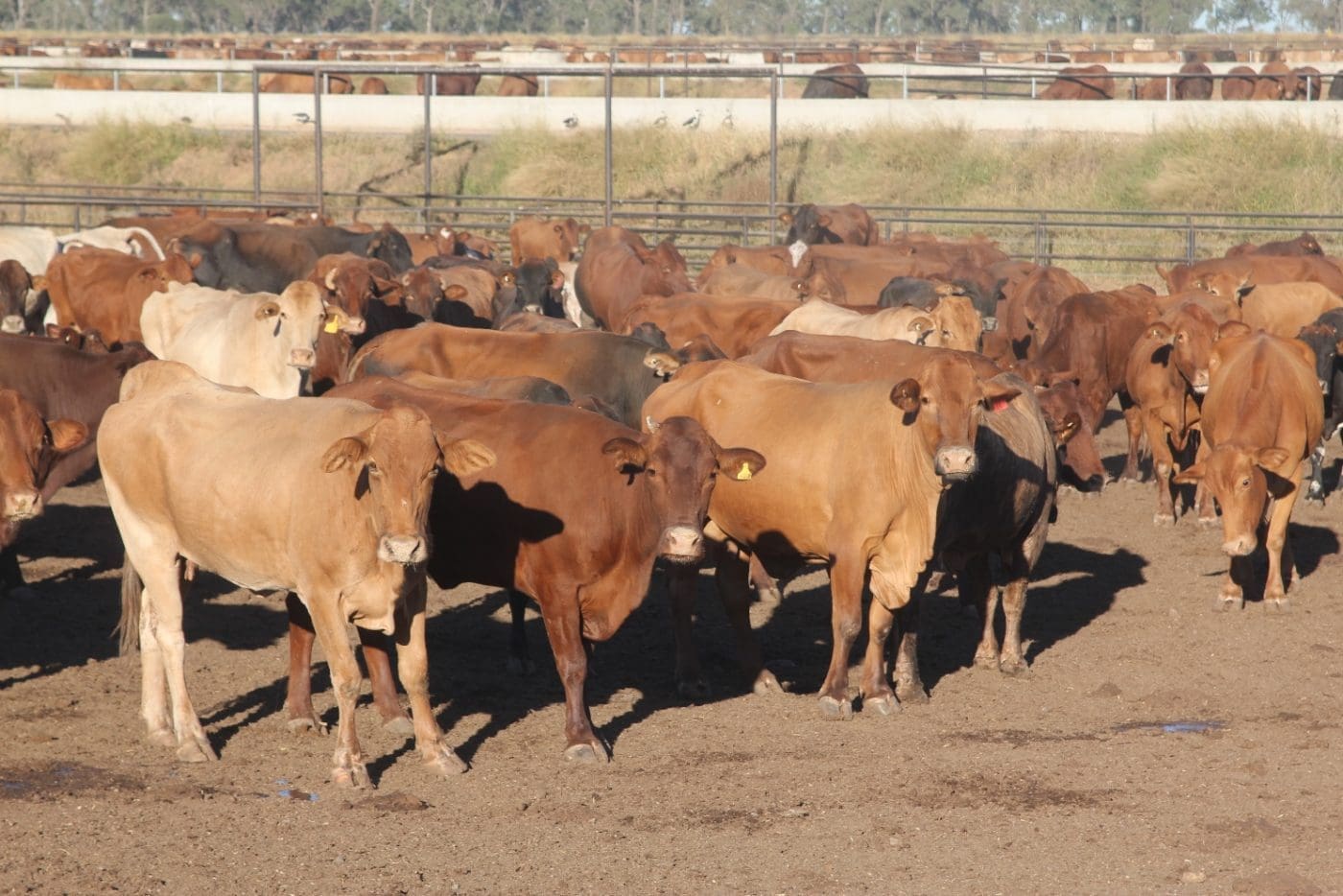
Northern-bred cows on shortfed programs in a Darling Downs feedlot this week
ONE of the features that is increasingly evident as the 2019 record-setting drought wears on is the sheer number of fed cows now finding their way to slaughter.
Exact numbers are difficult to distinguish, because cows are rarely, if ever fed long enough to qualify for a grainfed cipher, but anecdotally, the numbers appear to be large.
Females made up 48.5pc of Queensland’s kill last week and in NSW, 59.5pc, and it’s apparent that a considerable portion of those were cows that had spent time either in a feedlot pen, or supplementary fed on a mixed ration for a period in bunks in a nearby paddock.
Processors prefer cows with more weight, for efficiency reasons and quality reasons, reflected in grid price spreads which can often be 20c/kg better for better-finished cows +280 kg over lighter descriptions 220kg.
The trend may partly explain why carcase weights on females are tending to hold up better than expected this year, given the extent of the drought.
“A lot more lighter cows are now being fed for a period before slaughter, and the trend has grown as the year has unfolded,” one large multi-site processor told Beef Central this morning.
There were two or three operators buying better store cows at Dalby sale last week – not for direct slaughter, but to place onto feed to add weight and freshen up, typically over 40-50 days.
While consumption rates and conversion rates are not as good as a steer, gains can be impressive and a cow can easily add 75kg over a 50-day feedlot program, one stakeholder said.
“We’ve killed a lot of good cows over the past four or five months out of feedlots,” one large export processor said. “They get their 6-10mm of fat on them pretty quickly, and add a fair bit of weight. They are a different article coming out, than going in, from a processor’s perspective,” he said.

Matt George
Australian Lot Feeders Association’s technical services officer Geoff House said he had seen a lot of cows on feed during his recent travels around the industry.
Some were being fed for the new GrainFed Finished (GFF) industry standard, while others were simply being freshened up, with a minimum of 35 days on feed. The cows being fed for GFF cipher still had to comply with MSA grading. Most would not be on feed more than 50 days, he said.
“Depending on how backward they are, cows can go onto feed pretty quickly, and because they are already grown, they are not putting on bone, but only muscle and condition. Consumption rates can be quite high, but its not just about additional weight – they are increasing in cents-per-kilo as well,” he said.
One of the challenges was that because of how difficult conditions and circumstances had become across large parts of Queensland and NSW, a number of bought cows were dropping calves, which created management headaches in the feedlot environment.
“I think it is safe to say the number of cows being fed this year – either in proper feedlot pens or in paddock supplement situations – is unprecedented,” Mr House said.
Feedlot nutritionist Matt George said he had also observed large numbers of cows being fed this year, for short periods.
“It’s hard to put an accurate figure on it, but it is certainly in multiples of thousands,” Dr George said.
“It’s been going on for some months, but has continued to grow as the year has progressed, especially large runs of cattle off the Barkly Tableland, for example. It’s also being seen in NSW, in isolated locations, but it does seem to have grown more with locally-sourced cattle as meatworks grids have shown an indication of lifting a month or two ago.”
HGP decisions
Dr George said one of the decisions to be made by people considering feeding cows was whether to implant them or not, given recent interest in HGP-free supply (see earlier story).
Some no-HGP cow grids recently had offered premiums of 20-30c/kg and more, meaning some lines were not being implanted, sacrificing additional rates of gain available through implants.
Dr George said he was aware of one large run of reasonable crossbred cows that had been fed 60 days to maximise weight, but other programs were feeding as few as 35 days.
“But beyond 55-65 days on feed, the composition of gain in cows starts to change. Up to that point, it is reasonably good, with improved red meat yield, but they start to ‘tap-out’ (lay down excess fat) after that period. The only way to avoid that is to use more aggressive implant programs.”
For that reason, it was reasonable to assume that there had been high turnover of cows in Queensland and NSW feedlots over the past six months, Dr George said, because they were ‘in and out pretty quick.’
“I didn’t start to see the big numbers of cows on feed in our clients’ feedyards until probably April, but after that they started showing up in considerable numbers,” he said.
Grid prices steady
Weather conditions continue to drive cattle to market in large quantities, with processors in Queensland and NSW spoken to for this report saying they are still comfortably-off for supply for the early stages of September.
Hot weather predicted in southern states later this week may prompt another phase of sell downs, meaning early September kills are likely to remain stronger than anticipated earlier.
Grid prices in the key southern Queensland region remain unchanged this week, at 550-560c/kg on four-tooth ox (some plants 10c/kg less on HGP-treated, and 450-460c/kg on heavy cows. Central Queensland rates are 10c/kg behind that, and Townsville in the state’s far north 10c lower again.
Grainfed 100-day ox are worth 600c/kg this week in the spot market for southern Queensland kills, with one standout quote being one grainfed processor’s offer 710c/kg for quality Angus no HGP steers from 100-120 day programs.
NSW over the hooks prices last week declined 5c/kg on average, to 537c/kg, while heavy cows +280kg were unchanged at 467c. In Victoria, grown grassfed steers were unchanged last week at 567c/kg, while cows were a shade easier at 474c.
Kills lift
Last week’s eastern states beef kill lifted another 1pc to 151,236 head, still 7pc higher than this time last year.
Queensland’s production was 1pc less than the week before at 80,553 head, while NSW lifted 1pc to 35,457 head. In Victoria, processors accounted for 25.624 head, 1pc higher; in South Australia 4005 head, much the same as the week before; and in Tasmania 5597 head, up 49pc after one large plant’s weekly closure.
